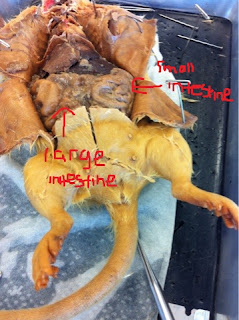Discussion Questions A:
1.) Hands are the best tools for dissections because it gives you more accuracy and stability when performing the dissection. It also gives you more control so you can really dig in deep into the organism
2.) The purpose for all the different labels and titles for the dissection are for us to know which body part is and to get a better understanding on what specific body part we are learning about
3.) The tail differs from the rest of the rat's body because it is used for stabilization and it helps the rat sense any near by preys or predators by vibrations

4.) the purpose of the vibriss are known to be used to tactile sensation and as they as well contain nerves in them
5.) bilateral symmetry means that if you were to draw an imaginary line down the longitudinal middle of the organism's body, the body's part would repeat on either side of the line
Discussion Questions B:
1.) the sphincter is described to be circular so that liquids are able to pass through. What the sphincter does is that it regulates the passage of some types of fluids, like urine
2.) There is a difference between the small and large intestine because the small intestine is known to be a slender coiled tube that receives partially digested food from the stomach. The width is smaller than the large intestine but is much larger in length. The Large intestine is where the final stages of digestion occurs. The Intestine consists of 5 sections, making it wider than the small intestine.
3.) The liver's function is to produce bile, which aids in digesting fat. It also transforms wastes into less harmful substances
4.) The name "duodenum." is from the latin "duodenum digitorum." which means 12 fingers breadth
5.) The purpose of the appendix is to protect your gut from germs but it as well produces good germs
Discussion Questions C:
2.) The spleen is associated with the circulatory system and functions in the destruction of blood cells and blood storage
3.) The diaphragm is associated with breathing in. Its a large layer of muscle that separates the thoracic from the abdominal cavity
4.) Atria: chamber of the heart that receives incoming blood
5.) the left ventricle is thicker than the right because it pumps the blood at a higher pressure. The left ventricle goes to all areas of the body where the right only has to pump blood to the lungs, which is a shorter distance, requiring less pressure
6.) in the male and female reproductive system their adrenal gland kidneys both are identical and connect to the their bladders
7.) the rat's kidney excretes wastes and regulates their water balance
8.) The thyroid, thymus, and adrenal glands are found in the endocrine system, the glands in the endocrine system influences in regulating mood, growth and development.








